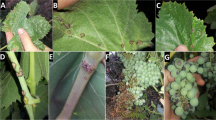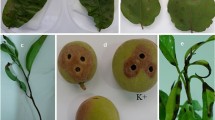Abstract
Common chicory (Cichorium intybus L.) as well as the spiny chicory (Cichorium spinosum L.) or “stamnagathi” in Greek, a bitter—sweet wild green, are two vegetables belonging to the Asteraceae family. Both species are commercially cultivated in outdoor fields and in greenhouses in various regions of Greece and particularly in Crete. During the years, 2014 and 2015 severe damage occurred in crops of C. intybus and C. spinosum in Crete. Typical symptoms in affected plants were marginal spots and lesions on leaves, and leaf blight. Initially, lesions appeared as water-soaked that later became brown, dry and papery, usually surrounded by a thin yellow halo or a brown to black border. Spots were gradually expanded and coalesced each other causing the blight of the leaves and finally the necrosis of the whole plant. In some cases, the diseased incidence reached 20 to 30% causing a significant reduction in yield and marketability of the product. The study of morphological, physiological and biochemical traits of the isolates as well as the pathogenicity tests indicated that the isolated bacteria belonged to group II of LOPAT discriminative tests, which contain the strains of Pseudomonas viridiflava. The phylogenetic analysis based on the B subunit of the gyrase gene (gyrB), and the amplification of a species-specific fragment confirmed P. viridiflava as the causal agent of the disease. This is the first record of the bacterium P. viridiflava as a pathogen of the common chicory in Greece as well as the spiny chicory worldwide. The disease can result in severe crop losses; hence, effective management practices should be investigated and applied.






Similar content being viewed by others
References
Alivizatos AS (1986) Tomato pith necrosis caused by Pseudomonas viridiflava Annales De L'institut Phytopathologique Benaki 15:41–47
Ayers SH, Rupp P (1919) A study of the alkali-forming bacteria found in milk. US Department of Agriculture, Washington D.C
Bartoli C, Berge O, Monteil CL, Guilbaud C, Balestra GM, Varvaro L, Jones C, Dangl JL, Baltrus DA, Sands DC, Morris CE (2014) The Pseudomonas viridiflava phylogroups in the P. syringae species complex are characterized by genetic variability and phenotypic plasticity of pathogenicity-related traits. Environ Microbiol 16:2301–2315
Billing E (1970) Pseudomonas viridiflava (Burkholder, 1930; Clara 1934). J Appl Microbiol 33:492–500
Bradbury JF (1986) Guide to plant pathogenic bacteria. CAB International Farnham Royal, Slough UK
Braun-Kiewnick A, Sands DC (2001) Pseudomonas. In: Schaad NW, Jones JB, Chun W (eds) Laboratory guide for identification of plant pathogenic bacteria. APS Press, pp 84–120
Burkholder WH (1930) The bacterial diseases of the bean. Memoirs Cornell University Agricultural Experiment Station 127:1–88
CABI (2021) Invasive Species Compendium. CAB International, Wallingford, UK
Caruso P, Catara V (1996) First report of Pseudomonas viridiflava leaf spot of red-leaved chicory. Plant Disease 80
Dodd CER (2014) Pseudomonas | Introduction. In: Batt CA, Tortorello ML (eds) Encyclopedia of food microbiology. Academic Press, Oxford, pp 244–247
Edgar RC (2004) MUSCLE: multiple sequence alignment with high accuracy and high throughput. Nucleic Acids Res 32:1792–1797
Edler D, Klein J, Antonelli A, Silvestro D (2021) raxmlGUI 2.0: a graphical interface and toolkit for phylogenetic analyses using RAxML. Methods Ecol Evol 12:373–377
Gitaitis R, Baird R, Beaver R, Sumner D, Gay J, Smittle D (1991) Bacterial blight of sweet onion caused by Pseudomonas viridiflava in Vidalia, Georgia. Plant Dis 75:1180–1182
Gitaitis R, MacDonald G, Torrance R, Hartley R, Sumner D, Gay J, Johnson W III (1998) Bacterial streak and bulb rot of sweet onion: II. Epiphytic survival of Pseudomonas viridiflava in association with multiple weed hosts. Plant Dis 82:935–938
Gitaitis R, Sanders F, Diaz-Perez J, Walcott R (2003). Integrated management of bacterial streak and bulb rot of onion. In: Pseudomonas syringae and related pathogens. Springer, pp 443–449
Gomila M, Busquets A, Mulet M, García-Valdés E, Lalucat J (2017) Clarification of taxonomic status within the Pseudomonas syringae species group based on a phylogenomic analysis. Front Microbiol 8:2422
Goumas D, Kaselaki A, Gatzilakis C, Chalakatevaki A (2009) Pseudomonas viridiflava: causal agent of a bacterial disease of Syngonium podophyllum Phytopathol Mediterr 48:317
Goumas DE, Chatzaki AK (1998) Characterization and host range evaluation of Pseudomonas viridiflava from melon, blite, tomato, chrysanthemum and eggplant. Eur J Plant Pathol 104:181–188
Goumas DE, Gatzilakis CX, Gouma SE (2008) Pseudomonas viridiflava is the causal agent of a new bacterial disease of artichoke. Phytopathol Mediterr 47:146
Goumas DE, Malathrakis NE, Chatzaki AK (1999) Characterization of Pseudomonas viridiflava associated with a new symptom on tomato fruit. Eur J Plant Pathol 105:927–932
Hort A (1916) Theophrastus enquiry into plants. Harvard University Press, Cambridge, MA
King EO, Ward MK, Raney DE (1954) Two simple media for the demonstration of pyocyanine and fluorescin. J Lab Clin Med 44:301–307
Klados E, Tzortzakis N (2014) Effects of substrate and salinity in hydroponically grown Cichorium spinosum J Soil Sci Plant Nutr 14:211–222
Kumar S, Stecher G, Li M, Knyaz C, Tamura K (2018) MEGA X: Molecular Evolutionary Genetics Analysis across Computing Platforms. Mol Biol Evol 35:1547–1549
Lamichhane JR, Venturi V (2015) Synergisms between microbial pathogens in plant disease complexes: a growing trend. Front Plant Sci 6:385
Lelliott RA, Billing E, Hayward AC (1966) A determinative scheme for the fluorescent plant pathogenic Pseudomonads. J Appl Microbiol 29:470–489
Liao C, Wells JJP (1987) Diversity of pectolytic, fluorescent pseudomonads causing soft rots of fresh vegetables at produce markets. 77:673–677
Lipps SM, Samac DA (2022) Pseudomonas viridiflava: An internal outsider of the Pseudomonas syringae species complex. Mol Plant Pathol 23:3–15
Malathrakis NE, Goumas DE (1987) Bacterial soft rot of tomato in plastic greenhouses in Crete. Ann Appl Biol 111:115–123
Mariano R, McCarter S (1993) Epiphytic survival of Pseudomonas viridiflava on tomato and selected weed species. Microb Ecol 26:47–58
Mulet M, Lalucat J, García-Valdés E (2010) DNA sequence-based analysis of the Pseudomonas species. Environ Microbiol 12:1513–1530
Nandagopal S, Kumari BR (2007) Phytochemical and antibacterial studies of Chicory (Cichorium intybus L.)-A multipurpose medicinal plant. Adv Biol Res 1:17–21
Palacio-Bielsa A, Cambra MA, López MM (2006) Characterisation of potato isolates of Dickeya chrysanthemi in Spain by a microtitre system for biovar determination. Ann Appl Biol 148:157–164
Petropoulos SA, Fernandes Â, Ntatsi G, Levizou E, Barros L, Ferreira IC (2016) Nutritional profile and chemical composition of Cichorium spinosum ecotypes. LWT 73:95–101
Pietsch RB, Vinatzer BA, Schmale DG III (2017) Diversity and abundance of ice nucleating strains of Pseudomonas syringae in a freshwater lake in Virginia, USA. Front Microbiol 8:318
Psaroudaki A, Nikoloudakis N, Skaracis G, Katsiotis A (2015) Genetic structure and population diversity of eleven edible herbs of Eastern Crete. J Biol Res (thessaloniki) 22:7
Puhlmann M-L, de Vos WM (2020) Back to the roots: revisiting the use of the fiber-rich Cichorium intybus L. taproots. Adv Nutr 11:878–889
Rozas J, Ferrer-Mata A, Sánchez-DelBarrio JC, Guirao-Rico S, Librado P, Ramos-Onsins SE, Sánchez-Gracia A, evolution. (2017) DnaSP 6: DNA sequence polymorphism analysis of large data sets. Mol Biol Evol 34:3299–3302
Samad A, Antonielli L, Sessitsch A, Compant S, Trognitz F (2017) Comparative genome analysis of the vineyard weed endophyte Pseudomonas viridiflava CDRTc14 showing selective herbicidal activity. Sci Rep 7:1–15
Sands DC, Schroth MN, Hildebrand DC (1970) Taxonomy of phytopathogenic pseudomonads. J Bacteriol 101:9
Sarris PF, Trantas EA, Mpalantinaki E, Ververidis F, Goumas DE (2012a) Pseudomonas viridiflava, a multi host plant pathogen with significant genetic variation at the molecular level. PLoS One 7
Sarris PF, Trantas EA, Mpalantinaki E, Ververidis FN, Gouma SE, Goumas DE (2012b) First report of Pseudomonas viridiflava causing a bacterial blight of artichoke bract leaves. Plant Dis 96:1223
Simopoulos AP (2001) The Mediterranean diets: what is so special about the diet of Greece? The scientific evidence. J Nutr 131:3065S-3073S
Stamatakis A (2014) RAxML version 8: a tool for phylogenetic analysis and post-analysis of large phylogenies. Bioinformatics 30:1312–1313
Torres-Cortés G, Garcia BJ, Compant S, Rezki S, Jones P, Préveaux A, Briand M, Roulet A, Bouchez O, Jacobson D (2019) Differences in resource use lead to coexistence of seed-transmitted microbial populations. Sci Rep 9:1–13
Wilkie P, Dye DW (1974) Pseudomonas cichorii causing tomato and celery diseases in New Zealand. N Z J Agric Res 17:123–130
Willett WC, Sacks F, Trichopoulou A, Drescher G, Ferro-Luzzi A, Helsing E, Trichopoulos D (1995) Mediterranean diet pyramid: a cultural model for healthy eating. Am J Clin Nutr 61:1402S-1406S
Yamamoto S, Kasai H, Arnold DL, Jackson RW, Vivian A, Harayama S (2000) Phylogeny of the genus Pseudomonas: intrageneric structure reconstructed from the nucleotide sequences of gyrB and rpoD genes. Microbiology 146:2385–2394
Young J, Cheesmur G, Welham F, Henshall W (1988) Bacterial blight of kiwifruit. Ann Appl Biol 112:91–105
Zhao M, Kvitko B, Gitaitis R, Dutta B (2021) Bacterial streak and bulb rot of onion. The Plant Health Instructor. https://doi.org/10.1094/PHI-E-2021-0421-01
Acknowledgements
This work was funded by the Education and Research Committee, Hellenic Mediterranean University (Research Actions of Phytopathology lab).
Author information
Authors and Affiliations
Contributions
All authors contributed to the study conception, design, and implementation. The first draft of the manuscript was written by Emmanouil Trantas and all authors contributed to the creation of the final edition. All authors read and approved the final manuscript.
Corresponding author
Ethics declarations
Conflict of interest
The authors have no competing interests to declare that are relevant to the content of this article.
Additional information
Publisher's Note
Springer Nature remains neutral with regard to jurisdictional claims in published maps and institutional affiliations.
Supplementary information
Below is the link to the electronic supplementary material.
Rights and permissions
About this article
Cite this article
Trantas, E.A., Malliarakis, D., Mpalantinaki, E.E. et al. Characterization of Pseudomonas viridiflava isolates associated with a new leaf spot disease in Cichorium species. J Plant Pathol 104, 1061–1070 (2022). https://doi.org/10.1007/s42161-022-01134-x
Received:
Accepted:
Published:
Issue Date:
DOI: https://doi.org/10.1007/s42161-022-01134-x




